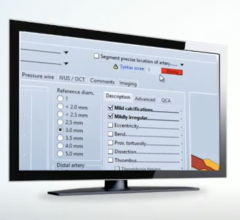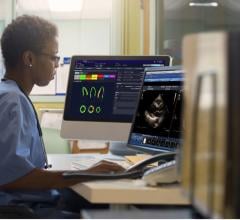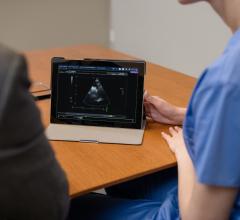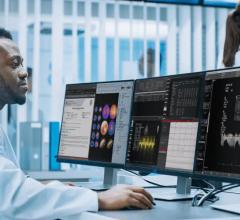
Two key requirements for today’s cardiovascular information systems (CVIS) are solid integrations with both enterprise-wide electronic medical record (EMR) systems and the catheterization lab’s hemodynamic monitoring system. Both will enable increased efficiency, faster workflows and the ability to meet data integration requirements mandated under U.S. healthcare reform in the coming years.
In the catheterization lab, the hemodynamic monitoring system is at the core of all procedures, so there needs to be solid integration with the CVIS. The hemodynamic data is not only important to interventional cardiologists, but to other users of the cath labs, including interventional radiology, vascular surgeons and electrophysiology. Tight integration between the CVIS and the hemodynamic system eliminates the need to manually tabulate or re-enter data that is already stored in an electronic format.
Integration With EMR is Key
Tight EMR integration allows all patient information from cardiology to flow into the EMR so there is a single access point for patient data, and duplicate data entry is avoided. An example of this integration can be found at Northridge Hospital Medical Center, a 411-bed hospital with two cardiac catheterization laboratories that is part of Dignity Health in Northridge, California.
The cardiology department’s McKesson CVIS system has a very open IT architecture, enabling it to easily integrate with the hospital’s Cerner EMR, adopted a year ago, said Michael Cromwell, RN, BSN, clinical manager of cardiovascular services. He explained CVIS vendors offer more robust systems with many more reporting parameters than offered by most EMR vendor reporting modules. However, without smooth EMR integration, the large EMR vendors will eventually build their own compatible CVIS module solutions.
“I think where everything is going will be the requirements set by the government for EMRs,” Cromwell said. “The future of the CVIS systems will be determined by how well they integrate with the EMR.”
Ed Lopez, cardiovascular service line director at Northridge Hospital, explained that each department at Northridge was using a different specialty reporting system from a variety of vendors. With the recent Cerner implementation, most of these subsystems were replaced with Cerner reporting modules. However, he said the complexity of cardiology required a dedicated CVIS that contained much more detail than what the Cerner system could offer. He said this is an issue with several of the very large EMR providers.
“None of those EMRs can document what we need, because we have a lot of things we need to capture in the cath lab,” said Lopez. “Any CVIS that can come up with a streamlined interface with the EMR will do well as integration becomes more important.”
Hemodynamic Integration
The Northridge Hospital cath labs previously used a Witt hemodynamic system and a stand-alone Optimed PACS (picture archiving and communication system) for imaging. Since these two systems did not integrate with the cath lab reporting systems, they were replaced with the McKesson CVIS in 2007. Nine years later the cardiology department is looking to upgrade its system with the latest McKesson CVIS because the system overall has addressed the department’s workflow and reporting needs.
A key component of the success of the system, and a CVIS point of difference when compared to EMR cardiac modules, was a smooth integration with the cath lab hemodynamic system. That integration allows multiple people to chart data on the same patient at the same time; the hemodynamic data immediately available in the CVIS physician report, instead of requiring a case to be closed and then the data is transferred after a procedure. The data also auto-populates and completes sections of the cath report as the procedure is in progress. Cromwell said these points have greatly improved workflow and efficiency.
Diagnostic cath reports are now finished after a procedure in about five minutes. Interventional reports can be completed within about 10-15 minutes, with the hemodynamic measures automatically populating some of the report fields.
Automatic transfer of hemodynamic data also helps reduce the manual process of transferring this information into registry reporting templates for the National Cardiovascular Data Registry (NCDR) CathPCI database. Cromwell said the time savings has allowed the full-time employee devoted to this reporting to assist with other department registry reporting, such as for the Society of Thoracic Surgeons (STS) registry.
This integration has been a big help when cardiologists need immediate information. The department's CVIS is also Web-enabled, so access is not limited to hospital workstations. “Anytime there was a referral in a case from an interventional cardiologist to a cardiac surgeon, the surgeon had to drive to the hospital and look at the images on one workstation located in the cath lab, and the same was true of echo,” Cromwell explained. “We had a really inefficient system. Now a cardiovascular surgeon can review a live angiogram at home to determine if a patient would be a candidate for bypass.”
Cardiac surgeons also access the CVIS to call up filed angiograms in the operating room so they have a detailed map of the coronary anatomy. Cromwell said in the past, they would access the image on a dedicated workstation and make a paper sketch of the anatomy, which was used to guide the procedure so a graft was not placed proximal to a lesion.
“We wanted our system where our cardiologists and our nurses could pull everything they need at one workstation,” Cromwell said.
Read the article "Improving Cath Lab Efficiency With Today’s Hemodynamic Systems."
Enabling Data Mining
Data analytics is becoming a major trend in healthcare because it allows real-time information of how well a department is performing or the impact in changes to workflow after the introduction of new technology. This is enabled by CVIS systems with analytical capabilities and the use of structured reporting, where measures and taxonomy are standardized so apples-to-apples comparisons can be made.
“I think structured reporting is very important,” Cromwell said. “You may feel your volume is up, but you need analytics to show this. You need that baseline to be able to make these types of comparisons.”
Northridge Hospital regularly uses its CVIS data analytics to measure procedure volume, types of procedures, what parts of the service line are doing well and which are stagnant, first case start times, and for cath lab credentialing. The CVIS analytics are starting to be leveraged to monitor echo and stress test report turnaround times.
“By posting these reports and showing physicians their numbers, we have seen drops in the reporting times,” Lopez said.
He said analytics from the CVIS are used on a regular basis to make business and management decisions.
Web-enabled CVIS Aids Workflow
Using a Web-enabled CVIS can help speed report turnaround times because physicians can access the information anywhere, either across the hospital or at home. This capability can greatly impact after-hours or late-in-the-day exam read times, where reports can be finished at home, rather than requiring physicians to stay late or drive in to read an exam.
“These guys are looking for quality of life, so if they are able to work at home with the same capabilities as if they were sitting at a hospital workstation, that is what they want,” Lopez said.
Comparison of Vendors' Hemodynamic Systems
This article served as an introduction to a comparison chart for hemodynamic monitoring systems. The chart includes six vendors involved in the U.S. market. Go to www.dicardiology.com/content/hemodynamic-monitoring-systems, it will require a login, which is free and only takes a minute to complete.
Chart participants include:
GE Healthcare
www.gehealthcare.com
McKesson
www.mckesson.com
Merge Healthcare
www.merge.com
Philips Healthcare
www.healthcare.philips.com
Siemens Healthcare
usa.healthcare.siemens.com
Mennen Medical
www.mennenmedical.com

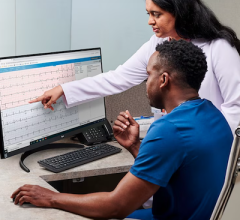
 November 06, 2025
November 06, 2025 


